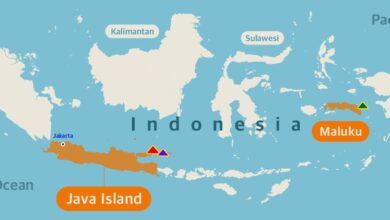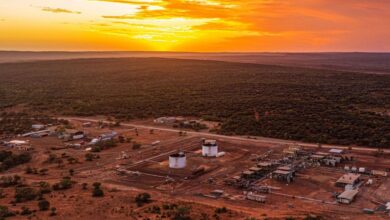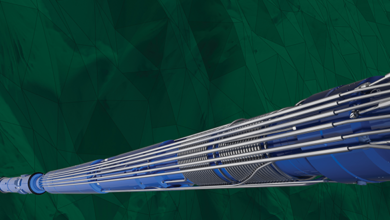AI, digital systems deliver better, faster insights for optimized bit designs
Advanced imaging and simulation software helping to automate traditionally manual processes, shortening design/testing cycles

By Stephen Whitfield, Senior Editor
The drill bit is one of the most essential parts of the drilling process, and bit manufacturers are pushing for innovations to enable better use of the copious amounts of data associated with the bit. By utilizing advanced digital and automated systems, manufacturers say they are continuously improving their ability to sort through and derive new value from that data, thereby producing new and innovative bit designs that can further drive well construction performance.
“As an industry, I think we’re moving in the right direction,” said Nicholas Lyons, Digital Product Manager – Drill Bits at Baker Hughes. “The key with improving performance is in the data quality, so it’s not necessarily figuring out how much data but ascertaining the quality of the data. We’ve got access to more data now than we’ve ever had before, but I think we’re in a position where we can vet that data to make sure we have that higher quality and where we can connect datasets to really power insights. That allows us to optimize and improve our drill bit designs.”
For several years, AI and machine learning algorithms have been helping manufacturers transform the traditional manual bit design process to a more digitally enhanced decision-making process. By developing algorithms that can process increasingly large amounts of data in ever shorter periods of time, engineers can push their design capabilities to the limits. This functionality is at the heart of NOV’s “digital manufacturing” efforts, backed by a collection of software programs that provide not only a full library of imagery but also analyses of that imagery.
“With a couple of clicks, our software can be used to look at bit dynamics and formations far quicker than we ever did before,” said Michael Bailey, Product Manager at NOV. “Everything’s processed in the cloud, and that allows design engineers around the world to talk about the same levels of data. That means we’re not just improving the processing of data, but also the communication around the large amounts of data that we get from our drill bits, as well as the design of those bits.”
Digital technologies are also helping to improve the kinds of data that can be gathered from the bit. For instance, SLB’s Retina at-bit imaging system is helping to generate high-resolution borehole imagery, critical for the accurate characterization of geological formations and structures. This functionality can help operators improve their well planning and placement, as well as enable informed decisions around field development. The technology addresses current imaging limitations, such as the inability to produce high-resolution images of large borehole sizes.
Additionally, by installing the system at the bit, instead of higher up the bottomhole assembly (BHA), the system does not encounter the time lapses that conventional imagers can encounter between the interaction of the bit and sensor with the rock. This makes the system better suited to avoid interference from the drilling fluid or from a damaged borehole, both of which can negatively impact the data coming into the sensor. The Retina system effectively turns the bit itself into a high-quality imager.
“The bit has to still do this job, shearing formation out and drilling the well, but now we’re using it to collect rock information and properly characterizing it,” said Roberta Santana, Product Champion – PDC Bits at SLB. “We’re still delivering the proper cutting structures, the proper bits that are going to perform, but now we’ve got this capability of enabling sensor activity for data collection and creating these borehole images.”
Optimizing data analysis
Baker Hughes has been focusing for years on automating the data gathering and analyses involved in bit design, Mr Lyons said. The company has created proprietary algorithms that can identify certain types of events by comparing disparate datasets; for instance, comparing surface data with at-bit sensing data to see how the bit performs in response to a given input, and tying that into the bit’s final dull condition.
“We can identify within our applications when data doesn’t quite match up with what we’re expecting, but now we’re at the point where we can automate more of that processing and determining if the data is of a good resolution, or if there’s variation in the data that does not make sense so we can pare things down. We can also highlight potential issues or events that require further investigation,” he said.
These algorithms power Baker Hughes’ Digital Dull Grading application, which calculates the damage of individual drill bit cutters using digital images as input. A digital model is trained to extract images of individual cutters, and image-processing techniques calculate the wear of each cutter. This automated dull grading process provides a higher level of reliability, consistency and accuracy, Mr Lyons noted.
Over the last two years, the company has further built up the capabilities of Tetrahedron, its proprietary bit drilling simulation software, by adding predictive capabilities. By using machine learning to refine its physics-based model coefficients on field datasets, the software can now predict how a given bit design will wear and break down over a set time period. This functionality allows the company to better understand how a bit design might need to be optimized for a given application.
Mr Lyons said the company’s focus has been on integrating the automated capabilities of the dull grading app with the modeling capabilities of Tetrahedron to create a comprehensive visual model that can predict bit wear over time in a given formation. These efforts are helping Baker Hughes to “close the feedback loop” on its digital dull grades while also enhancing the insights gained from the simulation software. “Being able to look at how we predict a bit will perform, and then actually being able to compare it to the final results in terms of how did the bit break down and where are we seeing the changes in efficiency – that capability has allowed us to really improve our bit designs.”
One instance where these enhanced capabilities improved bit design came last year, when an operator in the Colombia foothills faced challenges while drilling a 14 ¾-in. well section with standard PDC bits. The abrasive and interbedded Carbonera C5 and C6 formations consisted of sandstone, siltstone and claystone, with unconfined compressive strengths ranging from 5 to 25 kpsi. These conditions generated significant torque and vibrations that quickly dulled the bits, leading to low ROP and requiring four to five bits to drill the interval.
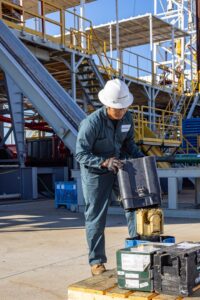
To address these challenges, Baker Hughes first introduced the Kymera Mach 6 bit, a hybrid bit with a dual cutting mechanism that has both the crushing capabilities of a roller cone – allowing it to drill with less torque and vibration than a PDC – and the shearing capabilities of a PDC – allowing it to drill faster than a roller cone. The bit proved successful in extending run length and improving drilling efficiency – average distance drilled increased by 17%, while torque variation and mechanical specific energy went down by 46% and 44%, respectively. The number of bits required for each section was decreased to two.
To help the operator improve its efficiency even further on subsequent runs, Baker Hughes then set bit design objectives to increase ROP and improve the reliability of the bearing and seal. After simulating various downhole conditions in Tetrahedron, the operator selected an optimized Kymera design that increased bit aggressiveness while maintaining torsional stability and durability. The design also improved load balance between the bit’s PDC and tungsten carbide insert cutting elements to help enhance the bearing and seal reliability.
“When we first introduced Kymera, we were able to reduce the number of bits that we used, but we were still seeing some issues with the cone reliability,” Mr Lyons said. “When we were in hole for a bit, we would see that the bearing on one of the cones was not in the best of conditions. Feeding that information back into our system, and running that data through our simulations, we were able to determine that one of the cones was taking on about 30% more load than the others. Adjusting that design and re-running it through our simulator, we were able to balance the load.”
In the next well, using the newly optimized bit for the 14 ¾-in. section, the operator was able to drill 50% more footage at 39% higher ROP compared with the average achieved by PDC bits in the Carbonera formations. When compared with the baseline Kymera design, the new bit design drilled 26% more footage at 33% higher ROP.
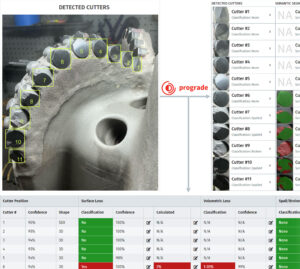
Building machine learning into bit design
Managing data is at the heart of NOV’s efforts to optimize bit designs, which encompasses transforming the design process to enable more digitally enhanced decision making. That means leveraging AI and machine learning to create what Mr Bailey termed a “digital manufacturing” ecosystem. NOV utilizes imaging software throughout its bit manufacturing process and has incorporated it into its Prograde bit dull grading software.
The company uses a separate program, Carbon, to create an image database showing exactly how a specific bit’s cutters evolved over the course of the bit’s lifecycle. The Prograde software can then use those images taken from Carbon to analyze the efficiency of given designs in given formations. Beyond that, another software program, Phosphor, places each bit run through Prograde into specific groups, marking various designs and models where, on average, each design type is seeing a given type of damage within a given bit run.
“We want to make sure we can track how our development goes,” said Adam Thomas, Software Engineering Manager at NOV. “If we must make a new design, we can connect that design to previous ones and allow people to investigate the lineage so that we understand if we made the right call – for example, if I wanted to make a design that does X and Y, but actually it did Z.”
Within the Prograde software, engineers can also input design changes to a given bit to see what types of improvements those changes would have delivered in the same bit run.
“Each dull grade or bit run is a data point, and it doesn’t describe the whole story of a trend of that bit,” Mr Bailey said. “The real insight comes from forming those trends, putting the links between the data points you’ve collected, and doing that as quickly as possible post-run with a large-scale amount of data. This allows us to make better decisions and incrementally improve product performance and consistency in design.”
NOV utilizes proprietary rock mechanics models within its Orbit software that are trained on field and lab tests for each cutter shape that the company offers. These models enable design engineers to simulate the performance of any cutter on a specific bit configuration in a given formation. Further machine learning algorithms were developed to help tweak the data-gathering and analytics capabilities of the software.
“We have physics-based models that give us that understanding about the rock and help us understand how the cutting structure performs. But when we want to adapt those models to something brand-new – like a cutter shape we’re developing, or some different drilling technology – we can use AI assistance to guide the machine learning algorithms in incorporating those new things faster. It’s key to helping us update those rock mechanics models,” Mr Thomas said.
The emphasis on digital manufacturing, as evidenced by NOV’s software systems and the analytical models within them, can enable highly accurate predictions on how various drill bits can behave in various formations, he added.
“Because we have our own internal system to understand dull grade and analyze designs, when we put cutters in various positions, we know precisely what shape is where on that bit from the start. We don’t have to look at a damaged cutter and try to guess what it might have been. We know we’ve got an ION+ Eclipse cutter on a ReedHycalog Evolve drill bit, we know what we’re expecting to see, and the models are trained to understand what kind of damage you would expect to see for a given cutter.”
While digital manufacturing reduces the need for humans to analyze data coming from the bit, Mr Thomas and Mr Bailey both emphasized that the bit design process still requires humans at every stage. The software programs are mechanisms that help people understand the potential impact of changes they’re considering with a bit design, but they do not generate the designs themselves. The programs just allow the human engineers to see the data and any relevant insights from the data as quickly as possible.
“This is all about enhancing the product testing loop and the design iteration loop for us,” Mr Bailey said. “You no longer have to wait around for two days for an e-mail to deliver a 25-megabyte file because all the data is now at our fingertips. We’re not trying to replace people. We’re trying to make sure that our people have the best tools to enable them to make the right decisions.”
Producing high-resolution images at the bit
Digitalization is not just enabling companies to improve their bit designs; it’s also key in leveraging the bit as a tool to generate higher-quality well data.
In May, SLB launched Retina, an at-bit imaging tool that enables the identification of formation characteristics to optimize drilling efficiency and formation evaluation. The tool provides precise measurements at the point of first contact between the drill bit and the formation. Images generated can have a resolution as high as 2 mm/10 microns, which Ms Santana said was nearly double the resolution of formation microresistivity imaging.
The key enabler in the Retina tool is a recording system tailored to accommodate sensors installed around the nose area of a PDC bit to capture formation details – including dips, fractures, facies and textures – without interference from any type of drilling fluid. The raw data is then processed to create a borehole image for formation characterization and rock properties qualification.
“Creating something like Retina is not poking a couple of holes in the bit and plugging in a sensor,” she explained, noting that the bit still has to do its job of shearing the formation and drilling the well. Adding the additional function of rock information collection involves considering the placement of the sensors within the bit. “If they are too close to the center of the bit, we can’t generate enough of a radius of the formation to give a properly sized borehole image. If they are too close to the shoulder of the bit, the workload can be too high, and that affects the quality of the data collected. You have to consider that trade-off.”
She added: “There is a very specific area in the bit where there’s a trade-off of enough formation being touched, together with the capability of data collection and the resolution of the images, as well as protecting the sensor from damage, that we have to consider.”
The Retina system operates without the restrictions faced by traditional imagers. For one, as traditional imagers are located further up the BHA, there is a lapse in time between the interaction of the bit with the rock and the interaction of the sensor with the rock. “If your well has any losses, washouts or anything else going on between the tool and the formation, that can create difficulties with the quality of the image. When you’re collecting data at the bit, that damage to the borehole has not happened yet and the bit face has not been impacted yet, so you’re going to get a higher-quality borehole image.”
Borehole size is another limitation that is removed. Because conventional LWD ultrasonic imagers produce low-resolution images, they have limited applications in large hole sections. By producing 2-mm image resolution, the Retina system can capture images of drilling holes larger than 9 in., collecting vital data in the top-hole sections without requiring extra runs or additional tools in the BHA.
“Before, we weren’t really capable of getting that information in the top-hole sections, those 17 ½- or 16-in. sections. There was not much data there to complement our understanding of drilling or completions – for instance, where to set casing, or why is a bit not performing as we expected in the top-hole section? Now, there’s much more of an understanding of those layers.”
Field trials of the Retina system, conducted in an onshore well in Oklahoma last year, have already shown results. It was able to produce a high-resolution image of a thin-bed development within argillaceous facies, which SLB subsequently validated with a fullbore formation micro-imager run on wireline. Distinct sandstone packages and associated fine-grained facies with subtle variations in sinusoid dips were also noticed. LWD ultrasonic imaging run on the same well failed to differentiate those variations. DC


